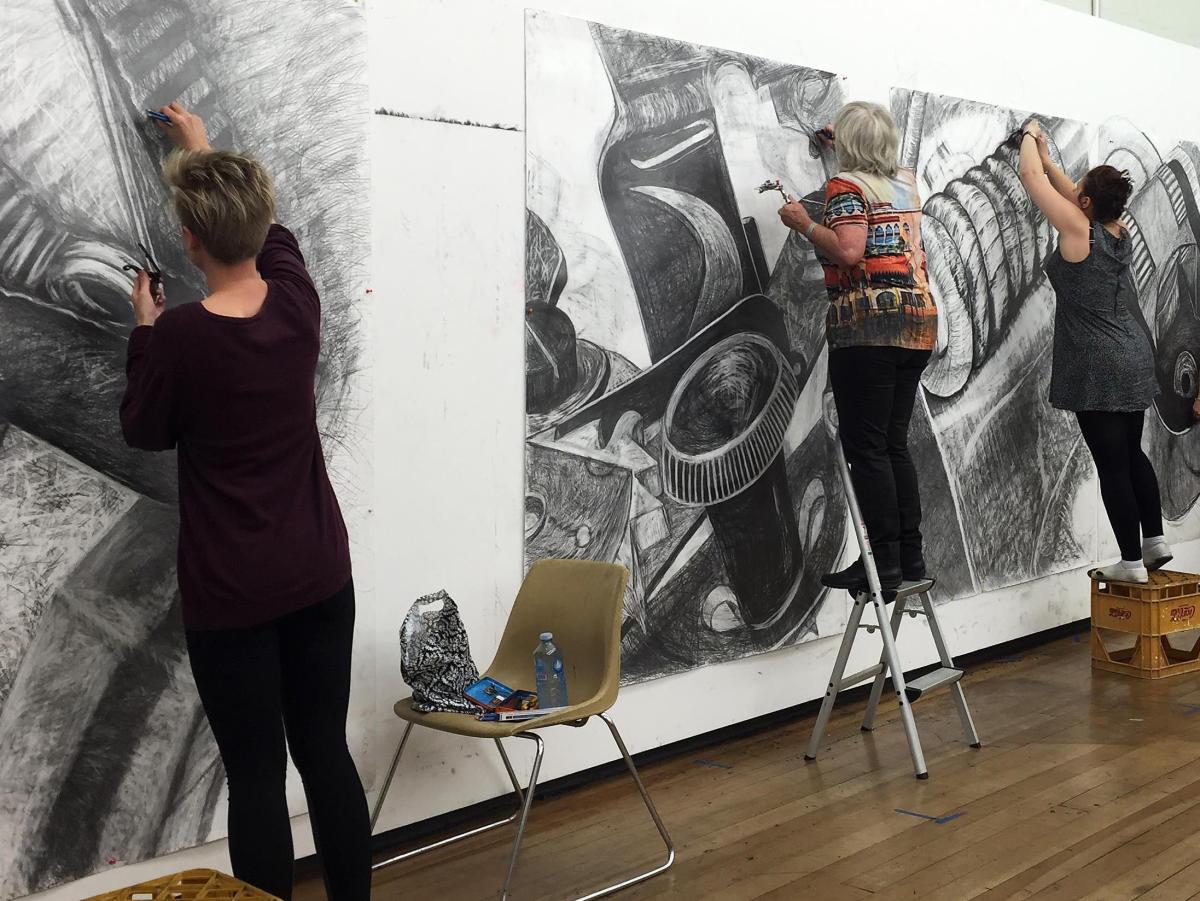Inneke Taalman (left) participating in a Level 2 Drawing class at Adelaide Central School of Art; supplied
The default position when considering art schools is usually either Sydney or Melbourne. But looking a little further west is proving to be a smart creative and economic alternative.
The Adelaide Central School of Art, or Central as it is colloquially known, is delivering big results.
‘While Adelaide might unfairly suffer a small town reputation, it offers everything a big city does but is more affordable,’ said Central student Inneke Taalman. ‘I have travelled a lot and I can say with complete confidence that I am not missing out on anything in Adelaide – they are completely on the pulse of contemporary art today.’
Taalman chose Adelaide’s studio-based school over a university as she had lost faith in that educational system. ‘I had friends impacted half-way through their studies from funding cuts and academic supervisors made redundant. I wanted an independent school that would inspire me. It was not about a hobby; I took that decision seriously, as this will be my career.’
The Adelaide Central School of Art offers three courses: a two-year entry level Associate Degree of Visual Art (ADVA), focused on building foundation skills in key aspects of visual art; a three-year Bachelor of Visual Art (BVA) designed to prepare students with the skills and knowledge to develop careers as practising artists; and a one-year full time BVA [Hons] program open to high-achieving students who have completed an undergraduate degree in visual art.
Andrew Herpich, Student Liaison Officer at Central told ArtsHub: ‘It is very different from the way teaching works elsewhere. We have a very small intake, typically only around 60 students annually – one intake in January to commence in February and the other in June to commence in July. That means that in a class situation it is a lot of one-on-one attention by established professional artist-teachers.’
Roy Ananda, Head of Drawing at Central and a practicing artist selected for the 2018 Adelaide Biennial of Australian Art, knows what it is like to have a portfolio career. He said: ‘I guess the bumper sticker way of saying it is we talk the walk and walk the walk, and it means that we are plugged in to advise and assist with career pathways from that coalface.’
Taalman said Central offers a great model because it shows that artists can aspire to have diverse careers where they can balance a professional practice with writing, teaching and curating. ‘In that sense we are really exposed to what it is like working today in the industry through the teachers – that is not something you can fake.’
Herpich added: ‘We build into our degrees things like tax and grant writing and how to liaise with galleries and art organisations – I am talking about them coming to the school, or the students going to them and sitting down one-on-one.
‘This kind of professional practice is built into all three years of our curriculum and is scaled in second and third years. In all other degrees you are training for a job, but as an artist you are your job.’
Adelaide has advantages over Sydney and Melbourne
Herpich said that in his experience, prospective students ask two main questions when considering Adelaide: confirmation that it is cheaper than living in Sydney as an emerging artist, and that there is enough activity outside the school to cater to different practices.
On both counts they are correct. ‘Another reason you might move is that the art scene in Adelaide is very much about collective activity – artist run initiatives, shared studio spaces and putting on group exhibitions. If you want to become part of an active community and a discourse that stimulates and prompts you to make interesting work from that perspective, then Adelaide is a good fit,’ said Herpich.
‘If you browse the lists of graduate and lecturer profiles on the school’s website you will start to get a good sense of how this community knits together’, said Ananda. ‘And there is not that anonymous face in the sea of a huge lecture theatre,’ he added.
The overwhelming feeling is that Adelaide Central School of Art punches well above its weight – an impression that is bolstered by the high calibre publication the school produces every year for its graduate show, and confirmed by any number of local ARIs with a good representation of graduates at the helm.
Taalman said, ‘I am genuinely impressed with the experience I am having and how I am being mentored. You can afford to be ambitious – that is important. People fudge their way through school and take the safer option but when you have someone pushing you and willing you to support that bigger idea, that is incredibly important. That was a deciding factor for me, and one that I could sense over the phone when I was doing my research on schools.’
Need help getting there?
Adelaide Central School of Art offers a number of Relocation Grants to assist students who are relocating from regional South Australia or interstate for study.
Herpich said, ‘$2,000 can be very helpful to get settled, pay a bond on an apartment, and cover some of the expenses that come with moving. We do it to show that we care and understand. The grants are not merit based; however, we want them to go to students with a decent study load.’
Applications are currently open and close 12 January 2018, for Semester 1.
The school also offers a $5,000 School Leaver Scholarship and a $7500 Bachelor of visual Art (Hons) Scholarship.
Learn more about Relocation Grants and Adelaide Central School of Art.
For course information visit www.acsa.sa.edu.au/study-options/





